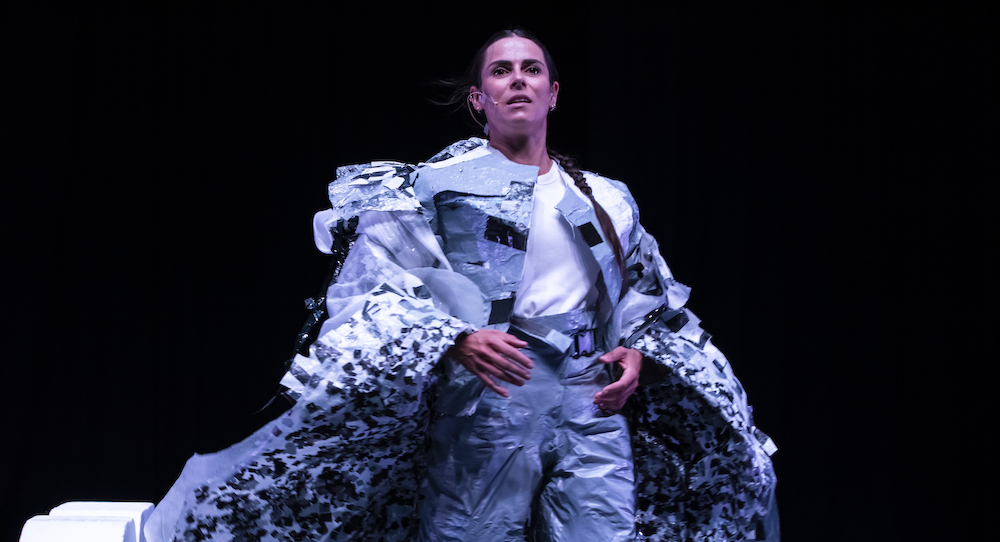Neilson Studio, Sydney Dance Company, Sydney.
21 August 2025.
The second instalment in the fourth year of Sydney Dance company’s INDance program – supported by the Neilson Foundation and curated by Artistic Director Rafael Bonachela – continued this week to carve out that rare space where dance can risk, unravel, and reimagine itself. Staged in the intimate Neilson Studio, INDance invites artists to test the boundaries of form, content, and audience expectation. If Week 1 signalled the breadth of possibilities in independent dance, Week 2 confirmed the depth – two distinct works that dared to confront, unsettle, and reframe how performance can embody the urgent questions of our time.
The first work, Progress Report, by Alison Currie and Alisdair Macindoe, performed by the commanding Rachel Coulson (to be performed by Geoffrey Watson on closing night) and with lighting, set and costume design by Meg Wilson, was far from just “another” work about the environment. Rather, it was a work of startling freshness – at once cerebral and visceral, absurd and deeply sobering. From the opening moment, Coulson drew the audience into a world where Styrofoam was no longer merely a disposable object, but a material charged with history, consequence, and uncanny theatricality.
A large industrial fan in the downstage corner set the stage in motion. Coulson entered with a single sheet of Styrofoam, experimenting with its buoyancy against the current of air. At first, the effect was almost comic, even unsettling – Styrofoam being perhaps one of the most recognisable symbols of unsustainability. Yet, very quickly it became clear that this was not a work seeking moral simplicity. Instead, Progress Report dissected consumerism, waste, and complicity, turning everyday detritus into both prop and antagonist.
As the performance unfolded, Coulson manipulated an expanding collection of polystyrene forms: rolls, half-pipes, thick crescents, a large figure 8. She stacked, balanced, and hurled them, then mirrored their shapes with her own body. Her movement quality was as articulate as it was forceful – technical precision meeting raw physicality. Each gesture was sharply defined, each sequence imbued with clarity. Her ability to transform inert matter into extensions of the body, or at times in oppressive forces to resist, was magnetic to watch.
Voice punctuated the work in surprising ways. At first, Coulson’s mutterings seemed like the frenzied babbling of someone overwhelmed by noise and excess. Later, fragments of text surfaced with clarity, tracing the invention and evolution of polystyrene across its near 90-year history; from industrial marvel to ecological catastrophe, from packaging material to micro and nano particles now infiltrating oceans and human tissue. What began as absurd humour edged into something much darker. The voice grew increasingly desperate, urgent, almost uncontainable – a reminder that the environmental crisis is not abstract but embodied, immediate, and inescapable.
The dramaturgy of the piece was subtle yet relentless. Fans positioned around the stage gathered the broken Styrofoam fragments into swirls of white confetti, a fragile blizzard of debris. A plastic bag suspended from fishing line drifted across the space, at once inconsequential and utterly haunting – later attaching itself to Coulson as if to suggest that no body escapes entanglement with waste. Eventually, she dragged a mountain of polystyrene blocks to the upstage corner, attempting to climb it as pieces toppled away. This accumulation of material – at once absurd and tragic – felt like a devastating metaphor for the persistence of waste, and the futility of trying to simply “discard” what cannot disappear.
The final image was striking: Coulson, now dressed in a makeshift suit of plastic and tape, scrambling upward as the stage faded to black. It was a vision of both resistance and entrapment, suggesting that even as we try to control the materials that define modern life, they are already remaking us in their image.
Developed over years (beginning in 2017, premiering in Adelaide in 2021, later Melbourne in 2023, and now Sydney), Progress Report is testament to the slow burn of an idea given space to evolve. In Coulson’s performance, it found an interpreter of immense force and clarity – one who could embody both the absurd humour and the crushing weight of the subject matter. This was not didactic theatre, but dance that insisted on complexity, contradiction, and confrontation.
If Progress Report was a tightly honed work of clarity and force, the second presentation of the evening, FM Air by Jo Lloyd, sat at the opposite end of the spectrum. The program notes promised a work that would “appear and disappear like a scent,” examining gendered behaviour through a “limitless, continuous loop.” What emerged on stage, however, felt far less expansive.
Three performers – Jo Lloyd, Louie Wisby, and Thomas Woodman – inhabited a shaky, vibrating physicality from beginning to end. Their bodies quivered, tapped, and jerked through a narrow vocabulary of gestures: crossing arms, tapping the head, pausing briefly before continuing. Sometimes they met, mostly they didn’t. The relentlessness of this single mode of movement created a sameness that soon became wearying, despite the performers’ commitment. It felt more akin to a performance art installation than to choreographed dance, its interest waning under the weight of its own repetition.
There were moments of intrigue. Early on, the three dancers entered the work encased within a vast tulle garment (costume design by Andrew Treloar and constructed by Treloar and Hailey Scott), moving as a single, trembling organism. The sheer fabric rippled and ballooned around them, creating fleeting images of beauty and disorientation. Yet, these textures were not developed, and soon dissolved back into the monotony of the shaky motif.
The program’s suggestion that the work interrogated gendered roles was difficult to locate in performance. Apart from the costuming – Lloyd and Wisby in pale blue and white, Woodman in orange – the work offered little engagement with the complexities of gender. What remained was a sense of an idea stretched thin: repetition without transformation, duration without dramaturgy.
Where Progress Report carved out a fresh and unsettling lens on consumerism, FM Air risked becoming self-referential, circling itself without offering new entry points. It was not without moments of invention, but over time it felt underdeveloped, more like a sketch than a complete idea.
Week 2 of INDance, then, offered a striking juxtaposition. On one hand, a rigorously crafted work in Progress Report, that translated urgent ecological themes into an embodied and haunting experience. On the other hand, a piece that seemed to resist choreographic structure in FM Air, its opacity ultimately limiting its impact. Yet, this contrast is precisely what makes INDance vital: it is a space where experiments can succeed or falter, where ideas can be tested in the presence of an audience. In this way, Week 2 reaffirmed the program’s importance – not only as a platform for polished excellence, but as a crucible where risk itself is valued.
By Linda Badger of Dance Informa.















